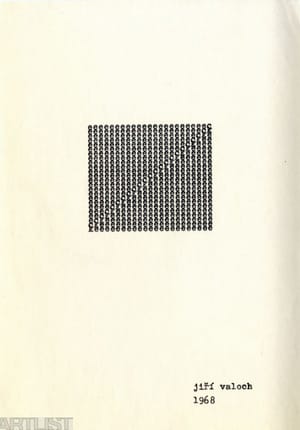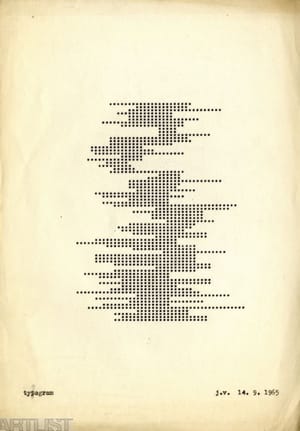- Members included in database
- Other members (not included in database)
-
Antal Eduard
Bartusz Juraj
Bartuszová Mária
Belohradská Ľuba
Belohradský Štefan
Beran Drahoslav
Bielecki Jiří
Böhm Svatoslav
Cepka Anton
Cicvárek Miroslav
Čihánková Jarmila
Čunderlík Marian
Dušek Jan
Gola Jindřich
Hampl Jiří
Hilmar Jiří
Hrdý Josef
Chatrný Ivan
Klimo Alois
Klimová Tamara
Kučera Zdeněk
Kurandová Jarmila
Malina Jaroslav
Maňka Pavel
Miertušová Anastázia
Pavlů František
Rajlich Tomáš
Rusek Jaroslav
Rybka Zdeněk
Trinkewitz Karel
Valenta Rudolf
Vystrčil Miroslav
- Founded
- 1967
- Dissolved
- 1971
- Place
- Československo
About group
Within the scope of nonfigurative art, in addition to the Informel movement, the geometrization form had also developed since the end of the 1950s and it was characteristic in its effort to be systematic and logical in processing. The works of Zdeněk Sýkora, Libor Fára, Karel Malich and other artists from the end of the 1950s can be considered as the initial works in this sense.
Concrete art, which was labelled in our environment mainly as a stream of constructive tendencies, was being formed in Czechoslovakia approximately since the beginning of the 1960s. This was primarily the environment of artists that later formed the group Křižovatka (Intersection). The main strategies included primarily the cleaning of mediums and clearer spreading in the sense of reduction of form. [see Pohribný, A.: KK po dvaceti letech (KK Twenty Years Later). Revue K, no. 1988-1989, pp. 32-33, nestr.]
Novelties in the field of science and technology played an important role here as the artists were eagerly learning these, also taking note of the aesthetical value of these achievements. It was no coincidence, therefore that the Czech and European construction artists were represented by a large number of designers [see ibid]. There was only sporadic information about similar artistic tendencies abroad. Nevertheless, the French New Realists or the group Zero can definitely be classified as inspirational sources.
The authors of constructivist tendencies found universal language in geometry, which became the medium for most directive and the cleanest form of art language [see ibid].
The actual Klub konkretistů (Concrete Artists’ Club) was founded in May of 1967 in Prague, but members from the entire Czechoslovakia started to quickly join as well. Some of the personalities in the Club included Radoslav Kratina, Dalibor Chatrný, Jiří Valoch, Eduard Ovčáček, Juraj Bartusz, Mária Bartuszová, Miroslav Cicvárek, Jiří Hilmar and others.
Similarly to other art groups of this period, this was also primarily a common opinion platform enabling better presentation and better exhibiting opportunities – the Concrete Artists’ Club did not strive to establish a style unity, rather to research emancipated art mediums and to have the possibility for intermediary connection , which could be implemented on several process levels [from the lecture of A. Pohribný Konkretismus – strukturování kosmických a energetických her (Concrete Art – Structuring Cosmic and Energetic Games), 14.4. 2000, Gallery Zbrojnice in Olomouc, cited from Daňková, J.: České geometrické a konkrétní umění a Klub konkretistů 2 (Czech Geometric and Concrete Art and Concrete Artists’ Club – Olomouc. Brno: Masarykov University, Faculty of Philosophy, 2008, pp. 63. Bachelor’s thesis work].
The first meeting of the Club took place in June 1967 in Ostrava and in Krnov; the manifesto was presented here, revue Arci 3,14 was founded and the possibilities of future activities were outlined. Arsén Pohribný (1928 – 2012) became the main theoretician and active organiser.
In the text of the program of the Concrete Artists’ Club’s second exhibition Pohribný characterizes the direction mainly as a new conception of the world using principles and constructional elements of technical nature. He also formulates the notion “concrete” lending the group its name: he uses the word concrete to describe a newly created aesthetically fascinating object. Concretes “can be perceived as a favourable paraphrase of “second nature” of industrial civilization, nature created by the human mass scale. Concrete artists do not perceive civilization and its objects as a hostile counterpart.” According to Pohribný, they identify themselves, through their work, with the civilization’s positive forces and they lead their audience to this harmonic unity by inviting it to participate on completing the art work.
He doesn’t speak about concrete art as a unified stream but as new ways and dimensions [see Pohribný, Arsén. Concrete Artists’ Club and guests, in: Ševčík, Jiří; Morganová, Pavlína; Dušková, Dagmar. České umění (Czech Art) 1938-1989. Programy, kritické texty, dokumenty (Programs, Critical Texts, Documents). Praha: Academia, 2001, pp. 309-310].
The first exhibition of the Concrete Artists’ Club took place in Austria at the summer university Forum Alpbach; 15 members and three guests exhibited their graphics [see Rojková, Alžběta. Výtvarné uskupení a výtvarný kritik. Klub konkretistů. (Art Grouping and Art Critic. Concrete Artists’ Club (Olomouc: Palackého University in Olomouc, Faculty of Education, 2009. Thesis Work, pp. 41].
Arsén Pohribný was generally very successful in his efforts to establish international cooperation and a number of world personalities participated as guests in the exhibitions of the Concrete Artists’ Club, for example Bridget Riley, Imre Bak, Jesus Rafael Soto and others.
The concrete artists’ second exhibition in Oblastní Gallery Vysočina in Jihlava in 1968 became pivotal – 26 members of the Club introduced themselves here as well as tens of invited guests. The member base of the Concrete Artists’ Club continued to grow in the subsequent years, which simultaneously contributed to the logical increase in the diversity of creative approaches. Unfortunately, together with the Normalization period and the growing social-political pressure this led to a gradual dissolution of the Club.
In 1997 – 30 years after the first exhibition of the Club in Jihlava, the Concrete Artists’ Club 2 originated following up on the activities of the original fellowship primarily with the creative work using geometrical language or visual poetry. It currently has several tens of members.
- Author of the annotation
- Kateřina Štroblová / Rathouská
- Published
- 2017
Exhibitions
- Other exhibitions/events
1998–1999
Klub konkrétistů, Alšova jihočeská galerie, Hluboká nad Vltavou 1998
Klub konkrétistů, Vila manželů Kontrbových, Klatovy/Klenová Klub konkrétistů, Oblastní galerie v Liberci, Liberec 1987
Klub konkrétistů 1967-1987, Galerie Rafay, Kronberg, D 1973
3 Konkretisten aus Prag, Museum Bochum, Bochum, D 1971
Galerie Interior, Frankfurt n.M., D 1970
Galerie Bazuin, Herlingen, NL Dům pánů z Kunštátu, Brno 1969
Klub konkrétistů a hosté, Kabinet grafiky, Olomouc Galerie Mahlestrasse, Vídeň, A Galleria Numero, Florencie, I Galleria Numero, Řím, I Galleria Numero, Benátky, I Pavilon, ZSVU, Bratislava, SK Galerie Pluijmen, Nijmegen, NL Klub konkrétistů a hosté domácí i zahraniční, Galerie umění Karlovy Vary Club van Konkretisten Praag, Tiffany´s Gallery, Den Haag, NL Heineken Galerij, Amsterdam, NL 1968
Galerie in Hause Behr, Stuttgart, D Klub konkrétistů, Dům kultury, Ústí nad Labem Klub konkrétistů, Galerie Václava Špály, Praha Výstava Klubu konkrétistů, Dom odborov a PKO Žilina, Žilina, SK Oblastní galerie Vysočiny, Jihlava 1967
Forum Alpbach, Alpbach, A
Monography, catalogues, publications
- Monography, catalogues, publications
2010
Valoch, Jiří. Klub konkretistů Východní Čechy (kat. výst.), Olomouc: Galerie Caesar, 2010. 2009
Rojková, Alžběta. Výtvarné uskupení a výtvarný kritik. Klub konkretistů. Olomouc: Univerzita Palackého v Olomouci, Pedagogická fakulta, 2009. Diplomová práce. 2008
Daňková, Johana. České geometrické a konkrétní umění a Klub konkretistů 2 – Olomouc. Brno: Masarykova univerzita, Filosofická fakulta, 2008. Bakalářská práce. 2001
Valoch, Jiří. Klub konkretistů: Dům umění v Opavě (kat. výst.), Opava: Dům umění, 2001. 1998
Jelínková, Dagmar (ed.). Klub konkretistů, Praha: Kant, 1998. 1997
Jelínková, Dagmar; Pohribný, Arsén; Valoch, Jiří. Klub konkretistů 1967-1997 (kat. výst.), Praha: Kant, Jihlava: Oblastní galerie Vysočiny v Jihlavě, 1997. 1993
Hlaváček, Josef; Sekera, Jan. Poezie racionality. Konstruktivní tendence v českém výtvarném umění šedesátých let. Praha: Národní galerie v Praze, České muzeum výtvarných umění v Praze ve spolupráci s Galerií Benedikta Rejta v Lounech, 1993. 1989
Pohribný, Arsén. KK po dvaceti letech. In Revue K, 1988-1989, č. 32-33. 1969
Pohribný, Arsén. Klub konkretistů: Galerie umění Karlovy Vary duben – květen 1969 (kat. výst.), Karlovy Vary: Dům umění, 1969. 1968
Pohribný, Arsén. Klub konkretistů (kat. výst.), Jihlava: Oblastní galerie Vysočiny, 1968. Pohribný, Arsén. Klub konkretistů: Galerie umění Václava Špály Praha, červenec 1968 (kat. výst.), Praha, 1969.
- Articles, media, internet
2015
Příkazská, Petra. Konkret/ism: Pocta i nová výzva, Ateliér, 2015, roč. 28, č. 16-17, s. 7. 2014
Štěpán, Petr. Klub konkretistů – 45 let poté, Ateliér, 2014, roč. 27, č. 2, s. 12. 2011
Sedláček, Zbyněk. Konkretisté v HK, Ateliér, 2011, roč. 24, č. 21, s. 1. 2009
Belohradská, Ľuba. Konstruktívne tendencie v zrkadle slovenskej umenovedy.
MADI art periodical, [online]. č. 4 [cit. 2009-04-01]. Dostupný z WWW:
http://mobil-madi.hu/?option=com_content&task=view&id=213&Itemid=63. 2002
Valoch, Jiří. Deset aktuálních podob konkrétního umění, Ateliér, 2002, roč. 15, č. 6. Gavlíková, Tereza. Geometrie hledání vztahu k sobě v prostoru, MF Dnes, 2002, roč. 13, č. 6, s. D/3. 2001
Valoch, Jiří. Klub konkretistů dnes, Ateliér, 2001, roč. 14, č. 19, s. 16. 2000
Kuracinová, Viera. Neokonštruktivizmus v slovenskom výtvarnom umení, Ateliér, 2000, roč. 13, č. 7. 1999
Pohribný, Arsén. 30 let Klubu konkretistů, Bulletin Moravské galerie v Brně, 1999, sv. 55, s. 155 - 6. Stachová, Lucia. Potvrdená správnosť abstraktného myslenia Klubu konkrétistov, Mosty: česko-slovenský týždenník, 1999, roč. 8, č. 16, s. 13. 1998
(fiš), Klub konkretistů na Klenové, Plzeňský deník, 1998, roč. 7, č. 193, s. 17. Pohribný, Arsén. Konkretisté zažívají novou vlnu zájmu o své geometrické umění, Klatovský deník, 1998, roč. 7, č. 180, s. 10. (lht), Znovuobjevení Klubu konkretistů, Karlovarské noviny, 1998, roč. 7, č. 59, s. 13. 1991
Pohribný, Arsén. Spod znamenia pricípu konštrukcie: Klub konkretistov po dvadsiatich rokoch, Výtvarný život, 1991, č. 3. 1982
Šmejkal, František. Český konstruktivismus, Umění XXX, 1982, s. 214-243.













